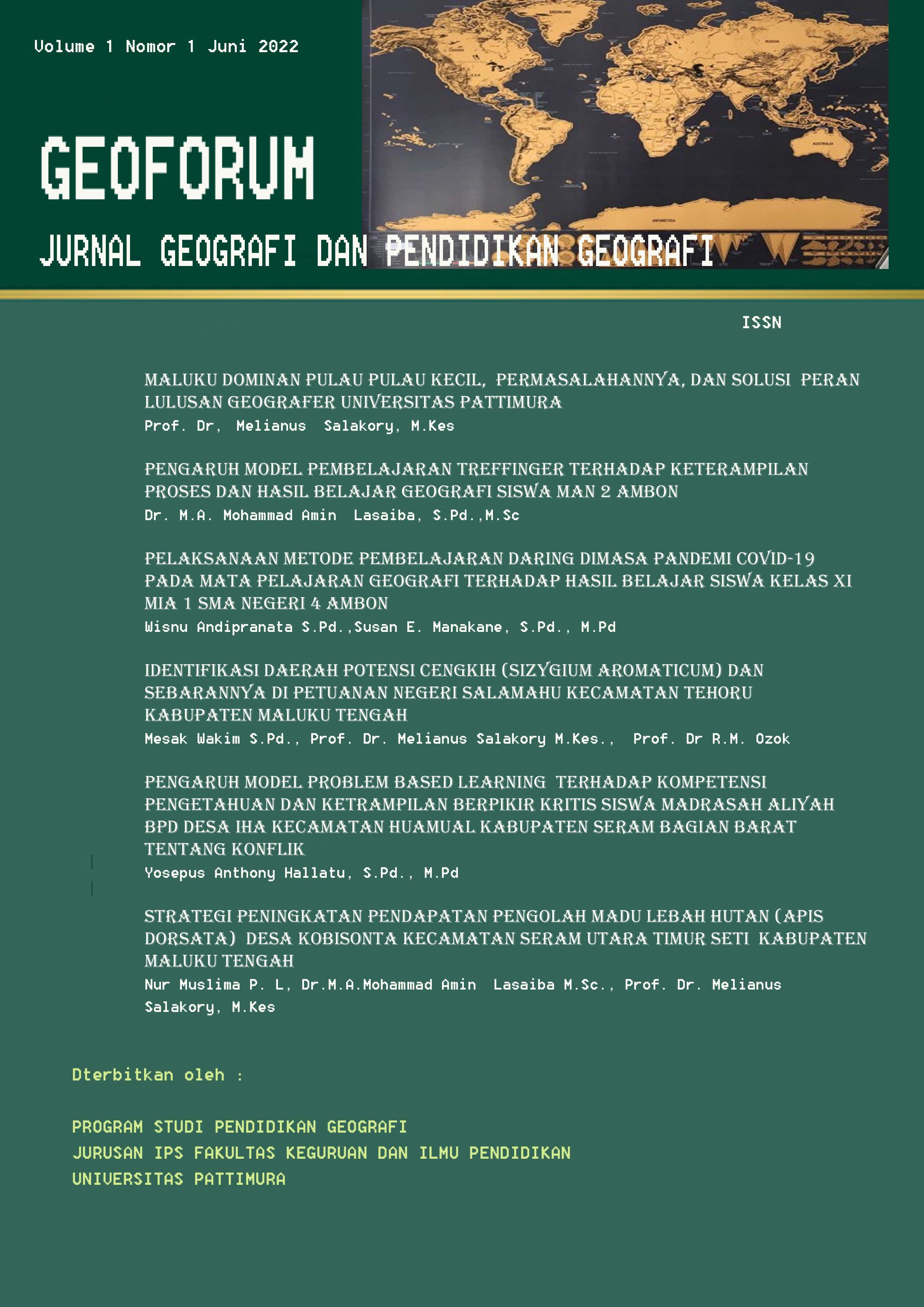Human Geography in the Context of Spatial Perspective
Geografi Manusia Dalam Konteks Perspektif Spasial
Abstract
Human geography is a branch of science that seeks to understand the complex interactions between humans and their physical environment. The spatial perspective is a central approach in human geography, emphasizing the importance of analyzing location, distribution, and spatial relationships in understanding geographical issues. This study explores various aspects of the spatial perspective in human geography, including its crucial role in understanding human geography, its historical development, and its theoretical implications. The introduction discusses the basic concepts of human geography and how the spatial perspective aids in analyzing human interactions with their physical environment. Furthermore, it explores the theoretical implications of the spatial perspective in human geography, including its impact on understanding human mobility, location and distribution analysis, and human vulnerability to natural disasters. The study also addresses the relevance of the spatial perspective in the context of future research directions in the field of human geography. Overall, this study highlights the essential role of the spatial perspective in understanding the interactions between humans and their physical environment within the framework of the human geography discipline.
Downloads
References
Aspinall, R. J. (2010). The Impacts of Climate Change on the Human Environment. Annals of the Association of American Geographers, 100(4), 983-999.
Adamo, S. B., et al. (2012). Climate Change and Migration: A Global Review. UN Population Division.
Agnew, J. (2011). Place and Politics in Regional Science. Regional Studies, 45(10), 1309-1323.
Anderson, B. (1991). Imagined Communities: Reflections on the Origin and Spread of Nationalism. Verso.
Black, R., et al. (2011). Climate Change and Migration: A Synthesis. IOM International Organization for Migration.
Banister, D. (2008). The Sustainable Mobility Paradigm. Transport Policy, 15(2), 73-80.
Brown, C. G., & Langer, A. (2015). Borderlines: Drawing the Canada–US Border. Social & Cultural Geography, 16(1), 9-27.
Berke, P. (2005). Does Sustainable Development Offer a New Direction for Planning? Challenges for the Twenty-First Century. Journal of Planning Literature, 19(2), 147-157.
Bunge, W. (1962). Theoretical Geography. Lund Studies in Geography, Series B: Human Geography, 4.
Berry, B. J. (1967). Central Place Studies: A Reintroduction and Appraisal. Prentice-Hall.
Burton, I., et al. (2002). From Impacts Assessment to Adaptation Priorities: The Shaping of Adaptation Policy. Climate Policy, 2(2-3), 145-159.
Brueckner, J. K. (2000). Urban Sprawl: Diagnosis and Remedies. International Regional Science Review, 23(2), 160-171.
Cervero, R. (1998). The Transit Metropolis: A Global Inquiry. Island Press.
Cutter, S. L., et al. (2003). Social Vulnerability to Environmental Hazards. Social Science Quarterly, 84(2), 242-261.
Cutter, S. L., et al. (2008). A Place-Based Model for Understanding Community Resilience to Natural Disasters. Global Environmental Change, 18(4), 598-606.
Chin, J. (2019). China and India Clash in the Himalayas: Why It Could Get Worse. The New York Times.
Ching, F. D. K. (1979). Architecture: Form, Space, and Order. Van Nostrand Reinhold.
Clarke, K. C., et al. (2015). A Geographic Information Science Agenda for 2015. Cartography and Geographic Information Science, 42(1), 2-13.
Castles, S., et al. (2014). Migration and Development: Perspectives from the South. ANU Press.
Dong, X., et al. (2019). Geospatial Technologies for Urban Planning: A Review. Remote Sensing, 11(22), 2635.
Diez, M. L., et al. (2016). Climate-Induced Land Cover Change in Western Himalaya: The Changing Face of Shiga Watershed, Himachal Pradesh, India. Sustainability, 8(10), 964.
Ewing, R., et al. (2016). Travel and the Built Environment: A Meta-Analysis. Journal of the American Planning Association, 76(3), 265-294.
Florida, R. (2002). The Rise of the Creative Class: And How It's Transforming Work, Leisure, Community and Everyday Life. Basic Books.
Field, C. B., et al. (2014). Climate Change 2014: Impacts, Adaptation, and Vulnerability. Part A: Global and Sectoral Aspects. Contribution of Working Group II to the Fifth Assessment Report of the Intergovernmental Panel on Climate Change. Cambridge University Press.
Gehl, J. (2010). Cities for People. Island Press
Goodchild, M. F. (2010). Twenty Years of Progress: Geographic Information Systems in Geography. Professional Geographer, 62(3), 340-351.
Gregory, D. (1994). Geographical Imaginations. Wiley-Blackwell.
Glade, T. (2003). Landslide Occurrence as a Response to Land Use Change: A Review of Evidence from New Zealand. Catena, 51(3-4), 297-314.
Haub, C. (2018). World Population Data Sheet. Population Reference Bureau.
Hardwick, S. W., et al. (2004). The Cultural Landscape: An Introduction to Human Geography. Prentice Hall.
Haggett, P. (2001). Geography: A Global Synthesis. Prentice Hall.
Henderson, V. (1988). Urban Development: Theory, Fact, and Illusion. Oxford University Press.
Hall, P. (1996). Cities of Tomorrow: An Intellectual History of Urban Planning and Design in the Twentieth Century. Blackwell.
Harvey, D. (1996). Justice, Nature and the Geography of Difference. Wiley-Blackwell.
Hartshorne, R. (1939). The Nature of Geography: A Critical Survey of Current Thought in the Light of the Past. Association of American Geographers.
Hammersley, M., & Atkinson, P. (2007). Ethnography: Principles in Practice. Routledge.
Hensel, P. R. (2001). Contentious Issues and World Politics: The Management of Territorial Claims in the Americas, 1816-1992. International Studies Quarterly, 45(1), 81-109.
Hansen, M. C., et al. (2013). High-Resolution Global Maps of 21st-Century Forest Cover Change. Science, 342(6160), 850-853.
Jacobs, J. (1961). The Death and Life of Great American Cities. Vintage.
Karan, P. P., et al. (2017). Introduction to Economic Geography: Globalization, Uneven Development and Place. Pearson.
Kasim, E. (2009). The Role of Transport in Regional Economic Development. OECD/ITF Joint Transport Research Centre Discussion Paper, 2009/21.
Kapos, V., et al. (2008). Calibrating Biodiversity: Simple Measures of the Effects of Non-Tariff Measures. Environmental and Resource Economics, 39(1), 45-57.
Kersten, M., et al. (2018). Air Pollution and Its Effects on Health - Case Studies, India. InTechOpen.
Lefebvre, H. (1991). The Production of Space. Blackwell.
Loo, B. P. Y., & Sander, H. A. (2007). Beyond the Edge: Multilevel, Multiscale Residential Transformation at the Urban–Rural Fringe. Housing Studies, 22(3), 385-409.
Lu, L. (2010). Wind Energy: An Introduction. John Wiley & Sons
Mercer, J., et al. (2008). Urbanization and Risk: A Review of Current Knowledge and Implications for Policy and Practice. Environment and Urbanization, 20(2), 411-427
Newman, P., & Kenworthy, J. (1999). Sustainability and Cities: Overcoming Automobile Dependence. Island Press.
O'Loughlin, J., et al. (1998). The Political Geography of "New" Regionalism in the Russian Federation. Political Geography, 17(8), 1073-1103.
Pelling, M. (2003). The Vulnerability of Cities: Natural Disasters and Social Resilience. Earthscan.
Paasi, A. (2003). Territorial Identities and Borders. Geopolitics, 8(2), 165-195.
Robinson, A. H., et al. (1995). Elements of Cartography. John Wiley & Sons.
Ravenstein, E. G. (1885). The Laws of Migration. Journal of the Royal Statistical Society, 48(2), 167-235.
Stark, O. (2004). Rethinking Human Capital Formation: Migration, Education, and Labor. Journal of Population Economics, 17(2), 343-365.
Sauer, C. O. (1966). The Early Spanish Main. University of California Press.
Sauer, C. O. (1925). The Morphology of Landscape. University of California Publications in Geography, 2(2), 19-53.
Sen, A. (2001). The Many Faces of Gender Inequality. New Republic, 7.
Soja, E. W. (1989). Postmodern Geographies: The Reassertion of Space in Critical Social Theory. Verso.
Seto, K. C., et al. (2011). Urban Land Teleconnections and Sustainability. Proceedings of the National Academy of Sciences, 108(20), 8044-8049.
Schiller, N. G., et al. (1992). Transnationalism: A New Analytic Framework for Understanding Migration. Annals of the New York Academy of Sciences, 645(1), 1-24.
Schaeffer, P. V., et al. (2018). Highways, Locomotives, and Migrants: Evidence of the Effects of Infrastructure Improvements on Population Flows. Journal of Development Economics, 132, 136-149.
Trewartha, G. T. (1981). An Introduction to Climate. McGraw-Hill.
Toole, M. J., & Toole, A. (2010). Eating, Farming, and the Spatial Organization of Agriculture in a Northern Somali Pastoral Community. Human Organization, 69(2), 152-164.
Tuan, Y.-F. (1977). Space and Place: The Perspective of Experience. University of Minnesota Press.
Turner, W., et al. (2015). Free and Open-Access Satellite Data are Key to Biodiversity Conservation. Biological Conservation, 182, 173-176.
Turner, B. L., et al. (1990). Two Types of Global Environmental Change: Definitional and Spatial Scale Issues in Their Human and Ecological Consequences. Global Environmental Change, 1(1), 14-22.
Wang, S., et al. (2011). Integration of GIS and Benthic-Pelagic Models to Assess Water Quality and the Impacts of Climate Change in a Coastal Bay. Environmental Modelling & Software, 26(3), 323-334.
Wisner, B., et al. (2004). At Risk: Natural Hazards, People's Vulnerability, and Disasters. Routledge.
World Meteorological Organization (WMO). (2018). WMO Statement on the State of the Global Climate in 2018. WMO-No. 1232.
Zelinsky, W. (1971). The Hypothesis of the Mobility Transition. Geographical Review, 61(2), 219-249.
Copyright (c) 2023 Mohammad Amin Lasaiba

This work is licensed under a Creative Commons Attribution 4.0 International License.





















